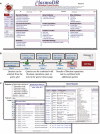PlasmoDB: a functional genomic database for malaria parasites
- PMID: 18957442
- PMCID: PMC2686598
- DOI: 10.1093/nar/gkn814
PlasmoDB: a functional genomic database for malaria parasites
Abstract
PlasmoDB (http://PlasmoDB.org) is a functional genomic database for Plasmodium spp. that provides a resource for data analysis and visualization in a gene-by-gene or genome-wide scale. PlasmoDB belongs to a family of genomic resources that are housed under the EuPathDB (http://EuPathDB.org) Bioinformatics Resource Center (BRC) umbrella. The latest release, PlasmoDB 5.5, contains numerous new data types from several broad categories--annotated genomes, evidence of transcription, proteomics evidence, protein function evidence, population biology and evolution. Data in PlasmoDB can be queried by selecting the data of interest from a query grid or drop down menus. Various results can then be combined with each other on the query history page. Search results can be downloaded with associated functional data and registered users can store their query history for future retrieval or analysis.
Figures

References
-
- Singh B, Kim Sung L, Matusop A, Radhakrishnan A, Shamsul SS, Cox-Singh J, Thomas A, Conway DJ. A large focus of naturally acquired Plasmodium knowlesi infections in human beings. Lancet. 2004;363:1017–1024. - PubMed
Publication types
MeSH terms
Substances
Grants and funding
LinkOut - more resources
Full Text Sources
Other Literature Sources
Molecular Biology Databases
Miscellaneous

